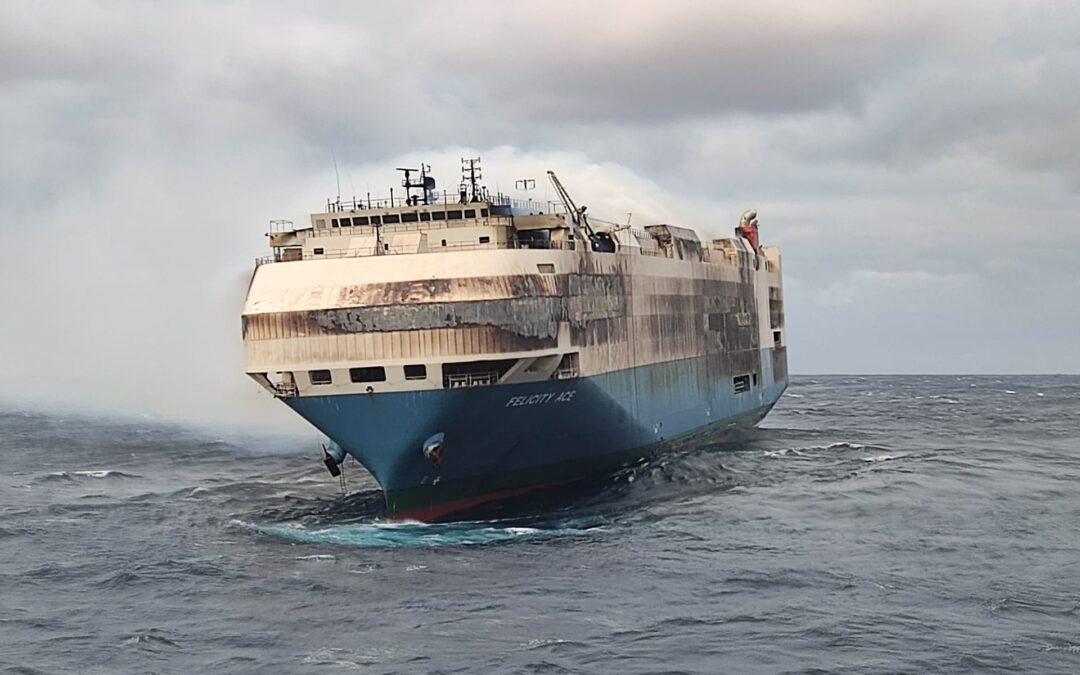Recent fire incidents involving the car carrier Felicity Ace and the passenger ferry Euroferry Olympia demonstrate that ship fires are still one of the biggest safety concerns for shipping. Insurance company Alliance points out that the number of fires on large ships has increased significantly in recent years and that fires are now the third cause of shipping losses in the last decade.
Although shipping losses have halved over the past decade, an analysis of the annual Safety & Shipping Review report by Allianz Global Corporate & Specialty (AGCS) shows that the number of fires on board large ships has increased significantly in recent years. In 2019 alone, there was a record of forty cargo-related fire incidents, or one every ten days. Across all ship types, the number of fires/explosions resulting in total losses reached a four-year high of ten by the end of 2020 – accounting for approximately one in five total losses worldwide.
‘The shipping industry has seen significant safety improvements over the past decade, with the number of total losses now at a record low,’ says Captain Rahul Khanna, Global Head of Marine Risk Consulting at AGCS. ‘However, fires on car carriers, roll-on/roll-off ferries (RoRos), container ships and other vessels remain among the biggest concerns for the industry, as evidenced by the recent rise in incidents.’
Also read: Felicity Ace still burning, Smit Salvage team on site
More fire risks for RoRos and car carriers
RoRo and car carriers can be more exposed to fire and stability problems than other vessels, and require additional emphasis on risk management.
Khanna: ‘RoRo and car carriers in particular, more than other vessels, can be exposed to fire and stability problems, and require additional emphasis on risk management. To facilitate the transportation of cars, the internal spaces are not divided into separate sections as in other cargo ships. The lack of internal partitions can have a negative effect on fire safety, and a small fire in one vehicle or battery can get out of hand very quickly. The vehicles are not easily accessible once loading is complete. The large amount of air in the open loading decks provides a ready supply of oxygen in case of fire.’
Also read: Fire on board Euroferry Olympia under control, eleven still missing
Other findings from the AGCS Safety & Shipping Review
- Notable recent incidents include the RoRo cargo ship, the Grande America, which sank after its cargo of vehicles and containers caught fire in March 2019. In June 2020, a blaze on the car carrier Höegh Xiamen lasted eight days before it was extinguished, while the RoRo passenger ferry Cruise Bonaria also suffered a fire.
- Fire/explosion is the third leading cause of total losses of ocean-going vessels in the last decade (2011 to 2020) with 99 total losses reported, accounting for about eleven per cent of total losses. The top two causes of total losses are sinking (54 per cent) and shipwreck/stranding (twenty per cent).
- Cargo ships account for forty per cent of total losses in the last ten years (348 out of 876). Passenger/cruise ships account for less than ten per cent (69 out of 876).
- Ship fires are the fifth leading cause of shipping incidents worldwide – over 1700 incidents have been reported in the last ten years (for all ship types), representing about seven per cent of all reported incidents.
- Container ship fires often start in containers, which can be the result of failure to declare or misdeclaration of hazardous cargoes, such as chemicals and batteries. When misdeclared, they can be packed and stowed on board inappropriately, which can lead to ignition and/or make detection and firefighting more difficult. The greater the number of containers on board, the greater the likelihood that at least one will ignite and cause a fire, and the more difficult it is to control and extinguish that fire. Another factor is the fire detection and suppression capacity in relation to the size of the ship. Ships are getting bigger every year, and major incidents have shown that fires can easily get out of control and cause the crew to leave the ship for safety reasons, thus increasing the amount of ultimate loss. There is a growing awareness of this problem, but it is still a major one.
Also read: ‘Ultra-large container ships bring unanticipated fire risks’
Picture by the Portuguese Navy (Marinha Portuguesa).








